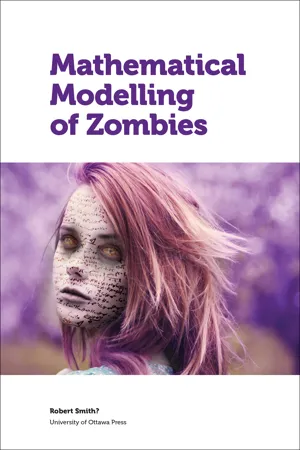
- 468 pages
- English
- ePUB (mobile friendly)
- Available on iOS & Android
Mathematical Modelling of Zombies
About This Book
In this terrible new COVID-19 world, the University of Ottawa is doing its part by offering a 50% discount on this very important book. We decided not to rewrite the witty book description, though we realize it is tone-deaf at the present moment, as we wanted to give readers a sense of the tone of this title. But don't be deceived: while a fun read, this book will help you better understand how epidemiologists, governments and health care planners use mathematical models to figure out how quickly epidemics and pandemics spread, in order to plan appropriately. Reading has perhaps never been as important, and this book should be at the top of your reading list.
You're outnumbered, in fear for your life, surrounded by flesheating zombies. What can save you now? Mathematics, of course.
Mathematical Modelling of Zombies engages the imagination to illustrate the power of mathematical modelling. Using zombies as a "hook, " you'll learn how mathematics can predict the unpredictable. In order to be prepared for the apocalypse, you'll need mathematical models, differential equations, statistical estimations, discretetime models, and adaptive strategies for zombie attacks—as well as baseball bats and Dire Straits records (latter two items not included).
In Mathematical Modelling of Zombies, Robert Smith? brings together a highly skilled team of contributors to fend off a zombie uprising. You'll also learn how modelling can advise government policy, how theoretical results can be communicated to a nonmathematical audience and how models can be formulated with only limited information. A forward by Andrew Cartmel—former script editor of Doctor Who, author, zombie fan and all-round famous person in science-fiction circles—even provides a genealogy of the undead. By understanding how to combat zombies, readers will be introduced to a wide variety of modelling techniques that are applicable to other real-world issues (biology, epidemiology, medicine, public health, etc.).
So if the zombies turn up, reach for this book. The future of the human race may depend on it.
Frequently asked questions
Information
THE ZOMBIE SWARM: EPIDEMICS IN THE PRESENCE OF SOCIAL ATTRACTION AND REPULSION
Abstract
15.1 Introduction
Table of contents
- Cover
- Title Page
- Copyright
- Dedication
- Contents
- Foreword: I Ran with a Zombie
- Introduction: What can zombies teach us about mathematics?
- The Viral Spread of a Zombie Media Story
- The Undead: A Plague on Humanity or a Powerful New Tool for Epidemiological Research?
- When Zombies Attack! Alternate Ending
- When Humans Strike Back! Adaptive Strategies for Zombie Attacks
- Increasing Survivability in a Zombie Epidemic
- How Long Can We Survive?
- Demographics of Zombies in the United States
- Is It Safe to Go Out Yet? Statistical Inference in a Zombie Outbreak Model
- The Social Zombie: Modelling Undead Outbreaks on Social Networks
- Zombie Infection Warning System Based on Fuzzy Decision-Making
- Is There a Zombicidal Maniac Near You? You’d Better Hope So!
- Zombies in the City: A NetLogo Model
- An Evolvable Linear Representation for Simulating Government Policy in Zombie Outbreaks
- Baneling Dynamics in Legend of the Seeker
- The Zombie Swarm: Epidemics in the Presence of Social Attraction and Repulsion
- Conclusion
- Contributors
- Afterword